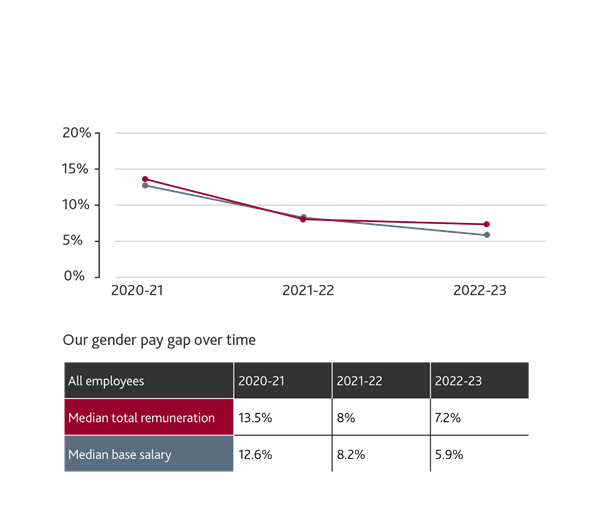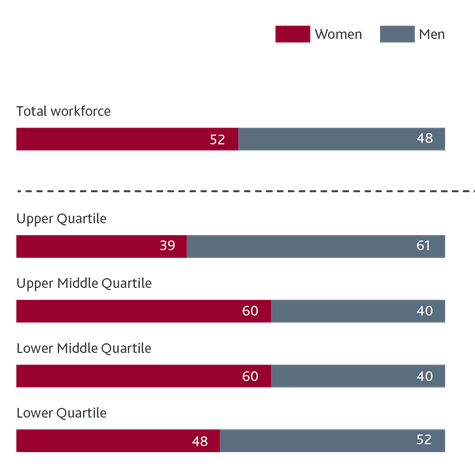Gender pay gap employer statement – our commitment to inclusion, gender equality and diversity
19 February, 2024
Peter O'Sullivan, Chief People Officer, BDO in Australia
Our commitment to inclusion, gender equality and diversity
At BDO, we value the differences and unique perspectives that every individual brings to our team. As a firm, we are committed to diversity and an inclusive culture where our people feel like they belong and can bring their true selves to work every single day.
Gender equality is one of the key priorities for our BDO Group Holdings Board with a commitment made by our Board Chair and Chief Executive Partner (CEP) to prioritise our inclusive culture, with a particular focus on gender.
The firm’s Board-endorsed gender equality strategy aligns with our business strategy and formalises our active dedication to gender equality in the workplace, which is critical for BDO’s success. Improving gender equality ensures an inclusive and safe environment for all our people and it will strengthen our quality of thought, collaboration, and perspective, leading to even better solutions for our clients.
Our priority areas of focus, against which we also measure our progress, centre around leadership accountability, inclusive culture, talent pipeline and capability development, and our working environment. This includes reviewing our policies, strategies and key governance roles through a gender lens, with particular attention to closing the gender pay gap and ensuring all our people are fairly and equitably rewarded.
BDO’s Culture Council, established in 2022, and chaired by the firm’s CEP Tony Schiffmann, is responsible for leading and championing the evolution of our culture so all BDO team members can be their best, no matter who or where they are. The Council, in conjunction with the BDO Group Holdings Board, plays a vital governance role to ensure the firm is meeting its strategic gender equality objectives and aspirations to be an employer of choice for gender equality.
Key findings from 2022-23 gender pay gap analysis
Overall employee gender pay gap
The average total remuneration gender pay gap across the organisation, measured by the WGEA methodology, is 15.9%, indicating that, on average, men earn 15.9% more than women. The industry comparison for accounting services is 19.7%.
Median gender pay gap
The median total remuneration gender pay gap across the organisation is 7.2%, which means that on average women earn 7.2% less than men using the median total remuneration rates.
The median base salary gender pay gap across the organisation is 5.9%, which means that on average women earn 5.9% less than men using the median base salary remuneration rates.
Notes:
- The 2022-23 gender pay gap calculation does not include voluntary salary data submitted for CEO and Head of Business(es).
- Total remuneration includes base salary, overtime, bonuses and additional payments. It also includes the annualised full time equivalent salaries of casual and part time workers.
- The median refers to the figure in the middle of the dataset and is expressed as the percentage difference between women’s and men’s earnings.
Since 2020-21 we have progressively been reducing the firm’s gender pay gap, as indicated by the graph below.

Our gender pay gap exists primarily because we have a higher proportion of men than women in senior roles. This leads to the average man being paid more than the average woman, which results in a gender pay gap. We continue to take active steps to ensure our women continue to progress to leadership roles and develop their career within the firm.
In fact, we have made strong progress in addressing our gender pay gap in client-facing roles up to Director level, with our gender pay gap in these roles sitting at 0.4% on a like-for-like basis at 1 July 2023. Closing our overall gender pay gap as measured by the WGEA methodology is more challenging but we are taking positive steps to reduce this over time.
Gender composition by pay quartile
Our employees are split into four groups equally (see graph below of split between male and female employees per quartile). For example, the lowest paid 25% of employees are split 52% male and 48% female.

We have a balanced representation of genders across the quartiles, which we expect will lead to a balance of genders as our employees progress through their career at BDO. We are particularly focused on the lower and upper middle quartiles to progress more women through to the upper quartile range.
Having more women in the upper quartiles aligns with a large proportion of women in leadership roles in our Shared Services function (non-client facing), for example our Chief Strategy Officer, Chief Digital & Innovation Partner, Chief Operating Officer and Chief Marketing Officer roles are currently held by women.
Historically, the gender pay gap is influenced by various social and economic factors including gender segregation in the workplace, women shouldering more of the unpaid caring responsibilities, and higher rates of women working part time, to name a few. A challenge we face is progressing women from the lower and middle quartiles into the upper quartiles for client facing roles. We are taking action to ensure more of our female employees are progressing through their careers into senior roles in the firm.
Factors influencing our gender pay gap
A key factor is gender segregation in support areas such as administrative roles, people and culture, clients and markets, and IT. These are not simply organisational or industry challenges but rather are reflective of gender segregation challenges across the whole economy and society. As a result, candidate pools for these roles reflect a lack of gender balance in these areas and making meaningful impact toward more balanced gender representation will be slower.
Further to this, more women have taken parental leave than men at BDO meaning they have been out of the workforce for longer. This in turn can impact career progression into the upper quartiles of client facing roles. Historically, men have taken less parental leave than women which also impacts our Gender Pay Gap. Our 2023 Sustainability Report showed that, on average, women are taking 48 weeks of parental leave compared to men who are taking 4.5 weeks on average. Further information around our family support measures and parental leave uptake by gender can be found here.
BDO is making positive progress toward achieving our gender representation target at Director level. We are seeing slower progress in achieving our target at Partner level, but we remain committed to this target and have measures in place that we believe will enable us to achieve it.
Getting our policy settings right has been another area of strong progress. Ensuring appropriate engagement with these policies, such as those relating to flexibility and family support, by men as well as women will likely remain challenging in the short term.
Our gender pay gap strategy and action plan
We are undertaking a multi-faceted approach to addressing the gender pay gap, tackling systemic and cultural factors that contribute to the disparity. Our gender equality strategy is key to making meaningful and sustainable change.
Cultural change is required to remove barriers to the equal participation of women in the workplace resulting from historical, social and economic factors – hence the firm’s commitment to inclusion and gender equality, governed by our Culture Council, Executive Leadership Team and Board.
Key actions and measures we have introduced and continue to work on, include:
- Launching a new gender equality strategy
- Tackling our overall employer gender pay gap, with a firm-wide target set to assist in making meaningful traction
- Undertaking detailed pay analyses to understand and address discrepancies at the position level across the firm
- Formalising our remuneration policy, ensuring pay equity objectives are included, roles and responsibilities are clear and integrating a gender pay review into the remuneration review process
- Building a consolidated career development process, with enhanced career conversations and clear guidelines to ensure objectivity
- Introducing targets for increasing the number of women in leadership roles
- Reviewing our recruitment practices to ensure we attract diverse talent and introducing a target for shortlisting women candidates for lateral hire Partner roles
- Establishing an internal promotions target for women per promotion cycle
- Review of people policies through a gender lens, including introduction of a new Family Support Policy (which provides greater paid leave provisions and superannuation on the unpaid portion of parental leave) and Flexible Working Policy (supplemented by manager training), ensuring equitable access for all genders
- Promoting flexible working arrangements for all our people across the firm and offering support for women returning to work through flexible working and part time hours, whilst also encouraging men to take advantage of these arrangements to enable them to fulfil their caring responsibilities
- Empowering our Culture Council to lead gender equality and inclusion initiatives and establishing a roadmap for clear direction, under the direct oversight of our Executive Leadership Team and Board
- Communicating our progress internally and externally.
The above integrated approach benefits all our people and strengthens talent retention within our organisation.
We recognise there is more work to do and that meaningful progress takes time. That is why we remain committed to addressing our gender pay gap and advancing inclusion and equality for all.